Never miss another geomagnetic storm. Sign up for Space Weather Alerts and you'll receive a text message when magnetic storms erupt. Aurora tour guides and professional astronomers use this service. You can, too! | | |
A DANGEROUS SUNSPOT: Sunspot AR3217 has a 'beta-gamma-delta' magnetic field that harbors energy for X-class solar flares. Indeed, it just unleashed one (see below). The sunspot is turning toward Earth so any flares this weekend are likely to be geoeffective. Solar flare alerts: SMS Text.
SOLAR FLARE AND RADIO BLACKOUT: Earth-orbiting satellites have just detected an X1.1-class solar flare from sunspot AR3217 (Feb. 11th @ 1548 UTC). Extreme UV radiation ionized the top of Earth's atmosphere, causing a strong shortwave radio blackout over South America:

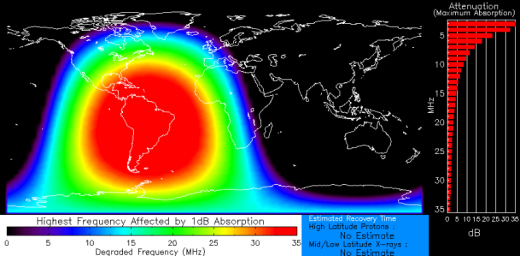
Ham radio operators, aviators, and mariners may have noticed unusual propagation effects at frequencies below 30 MHz for as much as an hour after the flare.
This was an impulsive flare, intense and fast. It may not have lasted long enough to lift a CME out ofthe sun's atmosphere. Confirmation awaits fresh data from SOHO coronagraphs. Stay tuned. Solar flare alerts: SMS Text.
Realtime Space Weather Photo Gallery
Free: Spaceweather.com Newsletter
GREEN COMET, RED PLANET: Comet ZTF (C/2022 E3) is having a close encounter with Mars. Michael Jaeger photographed the duo last night from AZM Martinsberg, Austria:
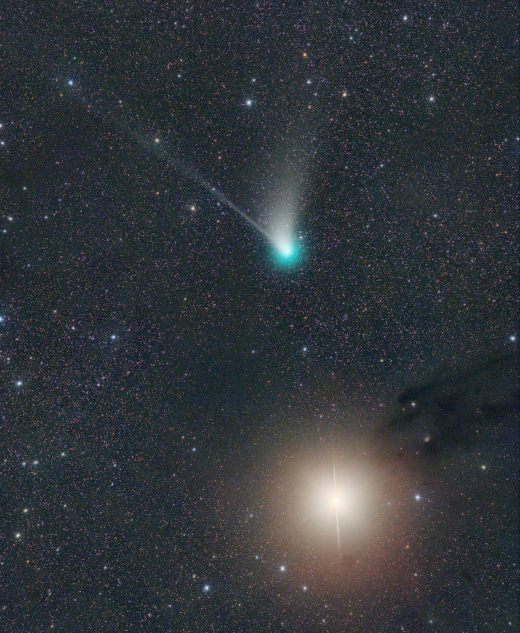
"Comet ZTF is approaching the ecliptic and is now near Mars," says Jaeger. On. Saturday night they will be less than 1 degree apart.
The two celestial bodies are a study in contrast. Mars is red (due to rust in the planet's regolith). Comet ZTF is green (due to diatomic carbon in its atmosphere). Mars is 100 times brighter and easy to see with the unaided eye. Comet ZTF is nearly invisible.
Astrophotographers, point your optics at Mars and take a long exposure. The comet will appear nearby. Got an image? Submit it here!
more images: from Ian Griffin of Portobello, New Zealand
Realtime Comet Photo Gallery
Free: Spaceweather.com Newsletter
18K GOLD CUPID'S COMPASS: Are you looking for a romantic gift? Consider Cupid's Compass. This premuim 18K gold-filled pendant flew to the stratosphere on Jan. 6th onboard an Earth to Sky Calculus cosmic ray research balloon:
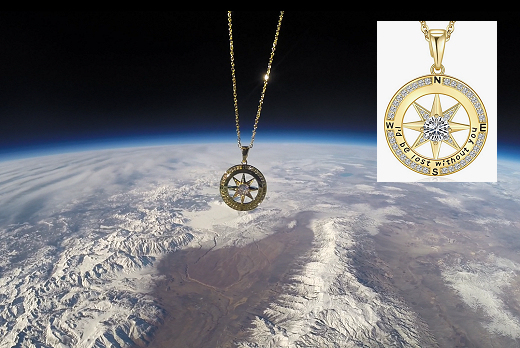
You can have it for $259.95. Engraved with the words "I'd be lost without you", the hypoallergenic pendant has a 5-star cubic zirconia crystal in the middle surrounded by a ring of equally high-grade 5A cubic zirconia nuggets. It is a visually striking pendant that makes a once-in-a-lifetime Valentine's, anniversary or birthday gift.
The students are selling space pendants to pay the helium bill for their cosmic ray ballooning program. Each one comes with a greeting card showing the jewelry in flight and telling the story of its trip to the stratosphere and back again.
Far Out Gifts: Earth to Sky Store
All sales support hands-on STEM education
CANYON OF FIRE: No sunspot was involved in this explosion. Yesterday, Feb. 10th, a filament of magnetism in a spotless region of the sun rose up and exploded. The filament sliced through the sun's atmosphere, forming a 'canyon of fire':
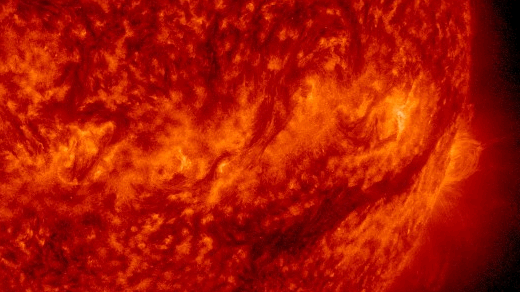
The exiting ribbon dragged enough of the sun's atmosphere with it to form a bright albeit slow-moving CME: movie. NOAA analysts have modeled the CME and determined that it will pass mostly south of Earth. However, a glancing blow is possible on Feb. 15th. Arctic sky watchers should be alert for auroras on that date. Aurora alerts: SMS Text.
Realtime Space Weather Photo Gallery
Free: Spaceweather.com Newsletter
Realtime Aurora Photo Gallery
Free: Spaceweather.com Newsletter
Every night, a network of
NASA all-sky cameras scans the skies above the United States for meteoritic fireballs. Automated software maintained by NASA's Meteoroid Environment Office calculates their orbits, velocity, penetration depth in Earth's atmosphere and many other characteristics. Daily results are presented here on Spaceweather.com.
On Feb 10 2023, the network reported 5 fireballs.
(5 sporadics)
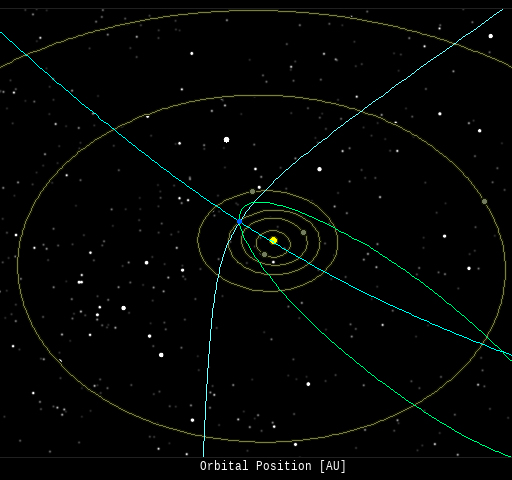
In this diagram of the inner solar system, all of the fireball orbits intersect at a single point--Earth. The orbits are color-coded by velocity, from slow (red) to fast (blue). [Larger image] [movies]
Potentially Hazardous Asteroids (
PHAs) are space rocks larger than approximately 100m that can come closer to Earth than 0.05 AU. None of the known PHAs is on a collision course with our planet, although astronomers are finding
new ones all the time.
On February 11, 2023 there were 2328 potentially hazardous asteroids.
 |
Recent & Upcoming Earth-asteroid encounters: | Asteroid | Date(UT) | Miss Distance | Velocity (km/s) | Diameter (m) |
| 2023 BT1 | 2023-Feb-06 | 16.9 LD | 8.8 | 30 |
| 2023 CC | 2023-Feb-06 | 3.9 LD | 9 | 22 |
| 2022 YO6 | 2023-Feb-06 | 12.1 LD | 13.4 | 159 |
| 2023 CO | 2023-Feb-06 | 6 LD | 6.6 | 35 |
| 2023 CT | 2023-Feb-07 | 4.2 LD | 13.2 | 17 |
| 2023 BU7 | 2023-Feb-08 | 1.3 LD | 1.7 | 3 |
| 2023 BS | 2023-Feb-08 | 19.4 LD | 10.9 | 35 |
| 2023 BO8 | 2023-Feb-08 | 4.2 LD | 6.6 | 16 |
| 2023 CU | 2023-Feb-08 | 2.2 LD | 4.7 | 13 |
| 2022 CX1 | 2023-Feb-09 | 17.4 LD | 13.2 | 14 |
| 2023 CR | 2023-Feb-09 | 2.2 LD | 8.1 | 9 |
| 2023 CF1 | 2023-Feb-09 | 8.7 LD | 5.8 | 9 |
| 2023 CA1 | 2023-Feb-09 | 5.7 LD | 12 | 23 |
| 2023 CB1 | 2023-Feb-10 | 7 LD | 7.1 | 16 |
| 2023 CQ | 2023-Feb-10 | 1.5 LD | 9.2 | 10 |
| 2023 BC8 | 2023-Feb-11 | 15.5 LD | 14 | 51 |
| 2023 CY | 2023-Feb-11 | 8 LD | 11 | 19 |
| 2021 EP4 | 2023-Feb-13 | 19 LD | 6.1 | 5 |
| 2023 CP | 2023-Feb-14 | 17.2 LD | 3.4 | 35 |
| 199145 | 2023-Feb-16 | 12 LD | 24.6 | 770 |
| 2022 RG | 2023-Feb-16 | 8.2 LD | 3 | 25 |
| 2020 DG4 | 2023-Feb-17 | 1.4 LD | 6.9 | 8 |
| 2023 CC1 | 2023-Feb-18 | 15.1 LD | 12.2 | 41 |
| 2023 CH1 | 2023-Feb-18 | 7.6 LD | 7.6 | 16 |
| 2023 CW | 2023-Feb-18 | 6.7 LD | 7.6 | 26 |
| 2020 CX1 | 2023-Feb-19 | 17.4 LD | 7.7 | 53 |
| 37638 | 2023-Feb-21 | 17 LD | 11.1 | 493 |
| 2023 AA2 | 2023-Feb-22 | 17.4 LD | 10.1 | 133 |
| 2023 CG1 | 2023-Feb-25 | 15.2 LD | 6.5 | 32 |
| 2012 DK31 | 2023-Feb-27 | 12.6 LD | 15.5 | 143 |
| 2006 BE55 | 2023-Feb-28 | 9.4 LD | 13.3 | 145 |
| 2021 QW | 2023-Mar-03 | 13.9 LD | 12.1 | 79 |
| 2017 BM123 | 2023-Mar-03 | 12.1 LD | 7.8 | 61 |
| 2007 ED125 | 2023-Mar-03 | 11.7 LD | 13.1 | 224 |
| 2015 EG | 2023-Mar-04 | 13.9 LD | 10.6 | 27 |
| 2023 BK5 | 2023-Mar-05 | 17.8 LD | 8.4 | 62 |
| 535844 | 2023-Mar-07 | 10.5 LD | 7.7 | 149 |
| 2020 FQ | 2023-Mar-09 | 14 LD | 6.3 | 13 |
| 2020 FV4 | 2023-Mar-13 | 17.6 LD | 8.2 | 30 |
| 2023 CM | 2023-Mar-14 | 10.4 LD | 14 | 190 |
| 2018 UQ1 | 2023-Mar-17 | 10.7 LD | 11.7 | 143 |
| 2016 WH | 2023-Mar-19 | 18.1 LD | 11.8 | 14 |
| 2018 FE3 | 2023-Mar-21 | 10.1 LD | 5.4 | 13 |
| 2022 YK4 | 2023-Mar-29 | 11.9 LD | 2.3 | 25 |
| 2017 SE12 | 2023-Mar-30 | 5.2 LD | 8.4 | 15 |
| 2016 GH1 | 2023-Mar-30 | 7.7 LD | 5.8 | 11 |
| 2022 GO3 | 2023-Apr-02 | 17 LD | 11.6 | 15 |
| 2021 GN1 | 2023-Apr-02 | 17.7 LD | 14.2 | 18 |
| 2018 FD | 2023-Apr-07 | 17.9 LD | 8.2 | 47 |
Notes: LD means "Lunar Distance." 1 LD = 384,401 km, the distance between Earth and the Moon. 1 LD also equals 0.00256 AU. | | Cosmic Rays in the Atmosphere |
SPACE WEATHER BALLOON DATA: Almost once a week, Spaceweather.com and the students of Earth to Sky Calculus fly space weather balloons to the stratosphere over California. These balloons are equipped with sensors that detect secondary cosmic rays, a form of radiation from space that can penetrate all the way down to Earth's surface. Our monitoring program has been underway without interruption for 7 years, resulting in a unique dataset of in situ atmospheric measurements.
Latest results (July 2022): Atmospheric radiation is decreasing in 2022. Our latest measurements in July 2022 registered a 6-year low:
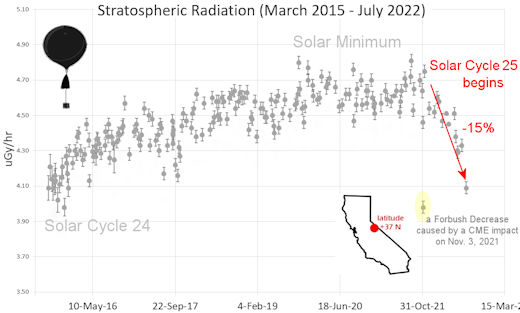
What's going on? Ironically, the radiation drop is caused by increasing solar activity. Solar Cycle 25 has roared to life faster than forecasters expected. The sun's strengthening and increasingly tangled magnetic field repels cosmic rays from deep space. In addition, solar coronal mass ejections (CMEs) sweep aside cosmic rays, causing sharp reductions called "Forbush Decreases." The two effects blend together to bring daily radiation levels down.
.Who cares? Cosmic rays are a surprisingly "down to Earth" form of space weather. They can alter the chemistry of the atmosphere, trigger lightning, and penetrate commercial airplanes. According to a study from the Harvard T.H. Chan school of public health, crews of aircraft have higher rates of cancer than the general population. The researchers listed cosmic rays, irregular sleep habits, and chemical contaminants as leading risk factors. A number of controversial studies (#1, #2, #3, #4) go even further, linking cosmic rays with cardiac arrhythmias and sudden cardiac death.
Technical notes: The radiation sensors onboard our helium balloons detect X-rays and gamma-rays in the energy range 10 keV to 20 MeV. These energies span the range of medical X-ray machines and airport security scanners.
Data points in the graph labeled "Stratospheric Radiation" correspond to the peak of the Regener-Pfotzer maximum, which lies about 67,000 feet above central California. When cosmic rays crash into Earth's atmosphere, they produce a spray of secondary particles that is most intense at the entrance to the stratosphere. Physicists Eric Regener and Georg Pfotzer discovered the maximum using balloons in the 1930s and it is what we are measuring today.
| | The official U.S. government space weather bureau |
| | The first place to look for information about sundogs, pillars, rainbows and related phenomena. |
| | Researchers call it a "Hubble for the sun." SDO is the most advanced solar observatory ever. |
| | 3D views of the sun from NASA's Solar and Terrestrial Relations Observatory |
| | Realtime and archival images of the Sun from SOHO. |
| | information about sunspots based on the latest NOAA/USAF Active Region Summary |
| | current counts of failed and deployed Starlink satellites from Jonathan's Space Page |
| | Authoritative predictions of space junk and satellite re-entries |
| | from the NOAA Space Environment Center |
| | fun to read, but should be taken with a grain of salt! Forecasts looking ahead more than a few days are often wrong. |
| | from the NOAA Space Environment Center |
| | the underlying science of space weather |
 | BestCSGOGambling is the best site for everything related to CSGO gambling on the web |
 | To find reviews of new online casino sites in the UK try The Casino DB where there are hundreds of online casino reviews complete with bonuses and ratings. Alternatively, Online-Casinos.xyz is another massive directory of online casinos listing sites for the UK and Worldwide. Casinos that offer Rupees for bonuses are very generous to Indian players. Find the best online casinos in India at AllCasinos.in Looking for a new online casino? Try Casimpo the new site dedicated to making online casino simple, or check out the new Avenger Slots Casino and Ace Online Casino with over 500 online slots and casino games. |
 | When looking for casinos to play online when the weather is bad, you can try casino online trucchi for Italian games. If you are not from Finland you can try the Swedish page Svenska casino online to find suitable games, check out svenskacasinoonline.net. Always check your local laws before playing with real money. |
 | Looking for sports betting companies not registered on GamStop? CasinoGap has presented a list of sites not on GamStop available for UK players. Check and bet online! Would you like to bet at sites not using GamStop? Look at a list of NonStopCasino sites for online betting that aren't on GamStop. Top-rated bookmakers ever! |
| | These links help Spaceweather.com stay online. Thank you to our supporters! |
| | | | | | |

